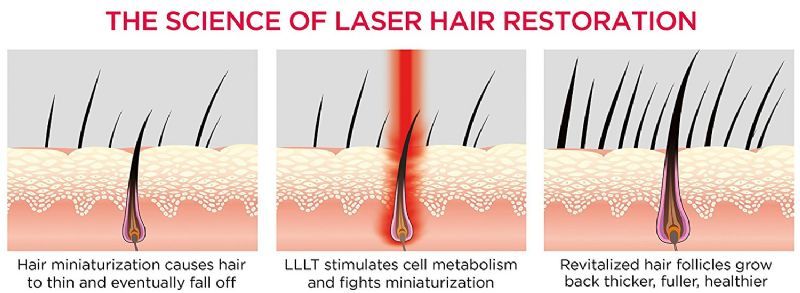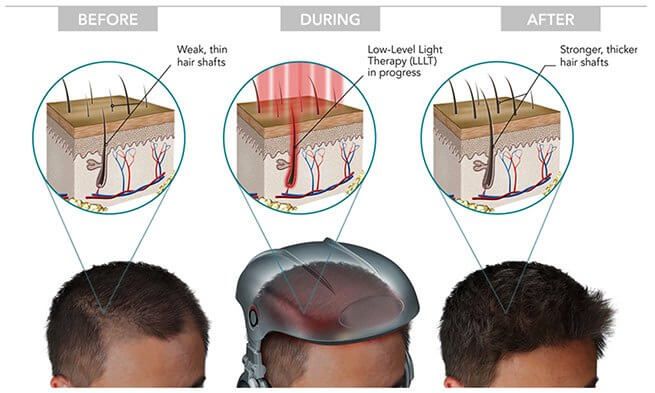 Written by Amanda Lundberg, BSN, RN
Written by Amanda Lundberg, BSN, RN
As a topic of considerable interest to the public, hair loss affects nearly 35 million men and 21 million women worldwide. In fact, 60% of men experiencing hair loss do so by age 50, while 50% of women will experience some degree of hair loss in their lifetime. With such astonishing numbers, it's no wonder that hair loss treatments have become increasingly popular. What many people don’t realize is that if they address their hair loss concerns as soon as they notice symptoms, they can determine the right treatment early and the condition may be reversible. While there are many different causes of alopecia (hair loss), including hereditary factors, hormonal changes, medical conditions, medications/supplements, radiation/chemotherapy, stress, and poor hair hygiene. However, as long as the hair follicle remains, low-level laser therapy has been proven to help. Read on to learn how this FDA-approved light therapy can help you or a loved one regrow beautiful hair.
 | Laser Hero Laser Caps for Hair Regrowth View Product |
Table of Contents |
Discovered in the late 1960s, low-level laser therapy (LLLT) is a non-invasive form of light therapy offering a diverse range of medical applications. Stimulating cellular activity with a single wavelength of light, LLLT emits no vibration, sound, or heat. Also known as cold lasers, photobiomodulation therapy, soft lasers, low-power laser therapy, and bio-stimulation, low-level laser therapy is used to enhance tissue repair and generate new, healthy cells. This is accomplished by sending photons through the different layers of the skin known as the dermis, epidermis, and subcutaneous tissue.
Interacting with light-sensitive elements in the cell, photons are absorbed and initiate a series of actions to help speed healing, normalize the affected tissues, reduce oxidative stress, enhance energy carrying molecules, and increase intracellular metabolism. Frequently utilized for nerve regeneration, wound healing, joint/muscle pain relief, and stroke recovery, LLLT has also become a popular and medically proven method for treating dermatological conditions, including hair loss.

Clinical trials have demonstrated that utilizing low-level laser therapy for hair loss appears to be both safe and effective in promoting hair growth for women and men. LLLT improves various non-scarring alopecia conditions, including AGA (androgenetic alopecia), AA (alopecia areata), and radiation and/or chemotherapy-induced alopecia. It has also been shown to be particularly effective when used in conjunction with hair transplant procedures as well as being a good complement for PRP (platelet-rich plasma) injection therapy.
The light wavelengths produced by low-level laser therapy for hair loss are absorbed by the molecules of the hair follicles, shifting them into the growth stage in a variety of ways. Stimulating the stem cells that regenerate hair follicles, LLLT promotes faster, healthier hair growth. By increasing blood flow to the affected areas of the scalp, the delivery of oxygen and nutrients to the hair follicles results in longer, thicker hair shafts for fuller-looking hair. This safe and painless therapy has been approved by the FDA for both men and women affected by non-scarring hair loss.

Although some people erroneously use these terms to describe the same type of LLLT photobiomodulation, there is a difference between red light therapy, cold laser therapy, and LED light therapy. Red light therapy often uses red and near-infrared light wavelengths to promote healing at the cellular level. Red light therapy with LED lights is safer and provides a more targeted, concentrated wavelength than regular LED lights, minimizing the energy needed to reach the affected area.
Cold laser therapy uses low-level lasers - which are much lower in intensity than the traditional high-powered lasers used to ablate tissue in surgical procedures. Calibrated to a specific wavelength, cold lasers provide a focused beam, delivering therapy more effectively than regular LED lights. A combination of low-level cold lasers and red LED lights will provide more efficacious results than either light therapy used alone.
 | Laser Hero Laser Caps for Hair Regrowth View Product |
Not all LLLT devices are created equally. Our product experts have found the Laser Hero Laser Caps for Hair Regrowth to be the leading at-home device available. FDA-cleared and clinically proven, the Laser Hero cap uses low-energy soft lasers to stimulate the growth of hair at the follicle. It’s ideally used for receding hairlines, thinning crowns, sparse areas of the scalp, and various types of hair loss conditions. Perfect for home use, its lightweight, hands-free design comes with universal sizing to comfortably fit adult scalps of any size.
Delivering discreet in-home hair loss treatments, the Laser Hero LLLT caps come in two different models - a standard model that includes 80 medical-grade lasers and 30 red LEDs, and a premium model that includes 204 medical-grade lasers and no red LEDs. Both models are superiorly effective at increasing hair health, density, and fullness. Results can be seen in just 12 to 24 weeks of doing 30-minute treatments several times a week!
Incredibly safe and easy to use, its wireless design fully charges in as little as 6 hours, enabling you to wear the cap as you work, watch TV, sit in bed, or clean the house. When used consistently, this innovative low-level laser therapy cap revitalizes the hair follicles, restoring thicker, healthier hair. Backed by clinical research, the Laser Hero laser caps give real, measurable results to restore hair.
No, low-level laser therapy does not hurt and is a non-invasive, painless treatment.
Although most people are very pleased with the results of LLLT for effectively treating their hair loss issues, there are a few reasons users won’t see the desired results. The most common reason for this is a lack of continuity. In the absence of an at-home device, people will need to attend multiple sessions per week at a clinic, which ends up being considerably expensive and time-consuming.
LLLT may also not be effective for some people who are in more advanced stages of hair loss. Additionally, this light therapy is contraindicated for people taking certain medications, including but not limited to photosensitizing medications. Furthermore, while the FDA has approved LLLT for home use and classified them as medical devices, their long-term safety and efficacy have not yet been established.
Less invasive than hair transplant surgery, low-level laser therapy for hair loss is a pain-free and drug-free method for growing longer, stronger hair. By investing in an at-home LLLT device, you are saving time and money by not visiting a clinic instead.
If your self-esteem has been negatively affected by losing your hair, using low-level laser therapy for hair loss may dramatically change your life. Hair loss that is ignored may create a permanent condition - once you lose the hair follicles, no therapy for hair growth will work. Talk to your healthcare provider to determine if LLLT is the right therapy for you.
Most people will experience hair regrowth in stages when using LLLT. Some will start seeing results in as little as 4 to 6 weeks. During the first several weeks, this therapy will start to control hair follicle oil secretion and inflammation, and improve serum secretion to a normal level. From about 4 to 14 weeks, the LLLT will stop hair loss and strengthen the hair shaft. After about 12 to 24 weeks, new hair gradually grows and becomes denser. At the 24 week mark of continuous use, the hair follicle gets thicker and healthier, improving in quality and quantity of hair.
It’s not too late to start using low-level laser therapy for hair loss if you still have hair follicles! It works by reactivating dormant and thinning hairs and is an effective therapy for a wide range of non-scarring alopecia causes. If you have areas of your scalp that are completely bald, there may be no way to promote hair growth, including LLLT. This is why it’s always recommended to address any hair loss issues as soon as this condition begins.
Although a vast amount of people experience hair loss of some type, many living with alopecia don’t know that treating this condition in its early stages can usually reverse it. Low-level laser therapy (LLLT) has been proven to regrow healthier and fuller hair in as little as 12 weeks and is FDA approved for safety and efficacy.
We found the Laser Hero Laser Caps for Hair Regrowth to be among the best LLLT devices as it boasts exceptional results with the ease and convenience of home-use. Its lightweight and wireless design allow users to engage in other activities while receiving therapy.
Experiencing hair loss can be a frustrating and disappointing period. It can affect self-confidence as well as put a hindrance to daily life. Many may feel hopeless in their search for a remedy. Regardless of how hair loss makes you feel, there is something you can do about it. As long as it is non-scarring, LLLT can be a profound therapeutic treatment to give you the results you desire.
Didn't find what you were looking for? Browse all Light Therapy products or our entire catalog of Therapeutic Modalities products.
Interested in learning more? Check out our free, educational resource Caregiver University. You will find incredible articles about light therapy, hyperbaric oxygen therapy, cryotherapy, and much more!
Want to get social? Find dozens of videos featuring products and tips like these on Rehabmart’s YouTube channel! And follow the RehabMart.com Facebook!

Amanda is a registered nurse with over a decade of experience in hospital, clinic, and healthcare management settings. Her primary focus has been collaborating with patients to manage disease processes. Aiming at continuing active lifestyles for her patients, Amanda has become an expert in adjunct therapies.
Amanda incorporates a holistic approach to heal the body from within. She has completed extensive research in remedial treatments using oxygen, as well as becoming a professional light therapy specialist. Her reparative ethos to health has sparked engaging conversations and teaching opportunities nationwide.
Amanda has taken her passion for articulating technical medical language and transitioned to freelance writing. She enjoys bringing a clinical voice to health and wellness brands.